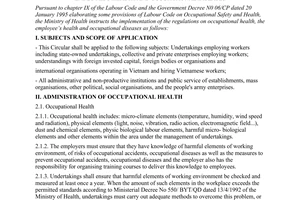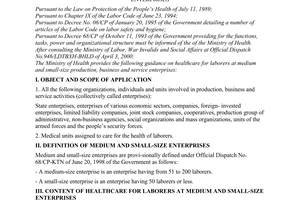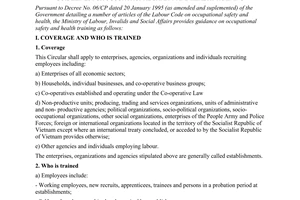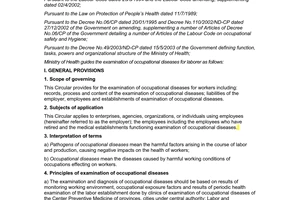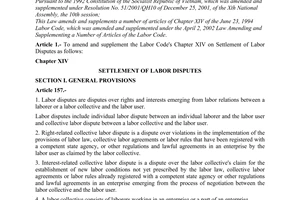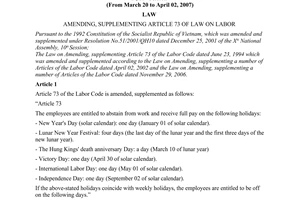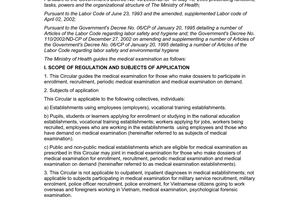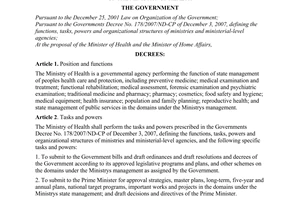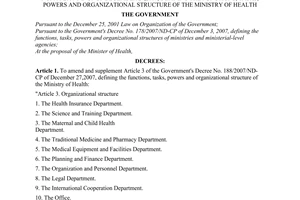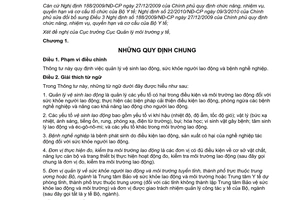Nội dung toàn văn Circular No. 19/2011/TT-BYT guiding the management of labor hygiene, laborers’ h
|
THE
MINISTRY OF HEALTH |
SOCIALIST REPUBLIC OF
VIET NAM |
|
No. 19/2011/TT-BYT |
Hanoi, June 6, 2011 |
CIRCULAR
GUIDING THE MANAGEMENT OF LABOR HYGIENE, LABORERS’ HEALTH AND OCCUPATIONAL DISEASES
Pursuant to the June 23, 1994 Labor Code and its amendments and supplements of 2002, 2006 and 2007;
Pursuant to the Government’s Decree No. 06/CP of January 20, 1995, detailing a number of articles of the Labor Code concerning labor safety and hygiene, and Decree No. 110/2002/ND-CP of December 27, 2002, amending and supplementing a number of articles of the Government’s Decree No. 06/CP;
Pursuant to the Government’s Decree No. 188/2009/ND-CP of December 27, 2009, defining the functions, tasks, powers and organizational structure of the Ministry of Health, and Decree No. 22/2010/ND-CP of March 9, 2010, amending and supplementing Article 3 of the Government’s Decree No. 188/2009/ND-CP of December 27, 2009;
At the proposal of the director of the Health Environment Management Agency,
Chapter 1
GENERAL PROVISIONS
Article 1. Scope of regulation
This Circular provides the management of labor hygiene, laborers’ health and occupational diseases.
Article 2. Interpretation of terms
In this Circular, the terms below are construed as follows:
1. Labor hygiene management means the management of elements in the working conditions and environment which are harmful to laborers’ health; application of measures to improve working conditions, prevent occupational diseases and raise working capacity for laborers.
2. Labor hygiene elements include climate micro-elements (temperature, humidity, wind speed); physical elements (heat radiation, light, noise, vibration, radioactivity, electromagnetic field); dust; chemical elements; pathogenic microorganisms; labor psychophysiology and ergonomics; and other elements in the working environment.
3. Occupational disease means a disease caused to a laborer’s health due to harmful working or manufacture conditions of a job.
4. Unit measuring and examining the working environment means a unit which is qualified in terms of physical foundations, personnel and equipment to measure and examine the working environment (below referred to as working environment measuring and examining unit).
5. Labor health and environment management unit of a province or centrally run city or a ministry or sector is the Labor Health and Environment Protection Center or provincial-level Preventive Health Center (for provinces having no Labor Health and Environment Protection Center) or the unit assigned to health management of a ministry or sector (below referred to as health agency of a ministry or sector).
Article 3. Management principles
1. All labor establishments must make and periodically supplement dossiers of labor hygiene management and dossiers of laborers’ health and occupational diseases.
2. The working environment must be measured and examined by qualified units under this Circular.
3. Labor hygiene, laborers’ health and occupational diseases shall be managed on the basis of management decentralization and line management combined with territory-based management.
Chapter 2
MANAGEMENT OF LABOR HYGIENE, LABORERS’ HEALTH AND OCCUPATIONAL DISEASES
Article 4. Labor hygiene management
1. To make labor hygiene dossiers according to the form provided in Appendix 1 to this Circular, covering the following principal contents:
a/ Part I. General situation of the labor establishment, including basic information on organizational structure, payroll; size and tasks; briefing of operating technological processes; hygiene of the surrounding environment and the working environment; health organization of the labor establishment; listing of machines, equipment and substances subject to strict labor safety and hygiene requirements;
b/ Part II. Labor hygiene of sections of the labor establishment;
c/ Part III. Listing of equipment meeting requirements on working environment hygiene safety;
d/ Part IV. Registration of regular examination of the working environment.
2. To plan annual labor hygiene management, covering schedule for measuring and examination of the working environment, and preventive and remedy solutions.
3. To measure and examine labor hygiene elements according to the form provided in Appendix 2 to this Circular.
4. For investment projects to build or set up labor establishments, to make health impact assessment reports under regulations.
Article 5. Management of employees’ health
1. Health management upon recruitment:
a/ To conduct medical examinations for employees and classify their health status before recruitment under Appendix 2 to the Health Ministry’s Circular No. 13/2007/TT-BYT of November 21, 2007, guiding the medical examination and assignment of jobs suitable to employees’ health;
b/ To make dossiers of employees’ health upon recruitment according to Form No. 1 provided in Appendix 3 to this Circular.
3. Regular medical examinations:
a/ To annually conduct medical examinations for employees, including also vocational trainees and trainee practitioners. To biannually conduct medical examinations for persons doing hard, hazardous, dangerous and exceptionally hard, hazardous and dangerous jobs and occupations under the Minister of Labor, War Invalids and Social Affairs’ regulations;
b/ The process of regular medical examination and recording in regular medical examination books comply with Appendix 3 to the Health Ministry’s Circular No. 13/2007/TT-BYT of November 21, 2007, guiding medical examination;
c/ To manage and list diseases of employees quarterly according to Forms No. 2 and 3 provided in Appendix 3 to this Circular;
d/ To make dossiers of laborers’ health management according to Forms No. 4, 5 and 6 provided in Appendix 3 to this Circular.
3. Examination of occupational diseases:
a/ To conduct medical examinations to detect occupational diseases for employees working under conditions vulnerable to contraction of occupational diseases;
b/ To conduct medical examinations to detect and regularly monitor occupational diseases under the process and procedures provided in Appendices 1, 2 and 3 to the Health Ministry’s Circular No. 12/2006/TT-BYT of November 10, 2006, guiding the examination of occupational diseases;
c/ To make and keep dossiers of occupational diseases management according to Forms No. 7 and 8 provided in Appendices 3 and 4 to this Circular and keep these dossiers till employees quit jobs, are retired or move to other labor establishments.
4. First aid for labor accident victims:
a/ To adopt plans to provide first aid for labor accident victims, including furnishing of emergency equipment suitable to the organization and operation of labor establishments;
b/ To annually provide training in first aid methods for hygiene safety staff and employees under Appendix 1, listing training contents on labor hygiene and first aid for laborers, to the Health Ministry’s Circular No.09/2000/TT-BYT of April 28, 2000, guiding health care for employees of small- and medium-sized enterprises, and the Labor, War Invalids and Social Affairs Ministry’s Circular No. 37/2005/TT-BLDTBXH of December 29, 2005, guiding the training in labor safety and hygiene;
c/ To make first aid dossiers for all victims of labor accidents happening in labor establishments according to Appendix 5 to this Circular and keep them till employees quit jobs, are retired or move to other labor establishments.
5. Sufferers of occupational diseases or victims of labor accidents may receive medical assessment for determining the level of working capacity loss under current regulations.
Chapter 3
PROVISIONS ON WORKING ENVIRONMENT MEASURING AND EXAMINING UNITS
Article 6. Conditions on working environment measuring and examining units
1. Conditions on physical foundations: To have an office with at least the following sections: administration and dossier receipt, dust and physical element testing, chemical and toxicant testing; microorganism testing; and assessment of labor psychophysiology and ergonomics;
2. Conditions on equipment: To comply with Appendix 6 to this Circular;
3. Conditions on personnel: Employees of a working environment measuring and examining unit must hold diplomas and certificates relevant to types of testing, certificates of training in supervision of the working environment and laborers’ health and occupational diseases and be qualified for conducting tests of working environment measuring and examination under Appendix 6 to this Circular.
Article 7. Dossiers and procedures for announcing working environment measuring and examination
1. A dossier of announcement of eligibility for working environment measuring and examination comprises:
a/ A statement of eligibility for working environment measuring and examination, made according to the form provided in Appendix 7 to this Circular;
b/ A list of personnel, a copy of the ground design and a list of equipment of the working environment measuring and examining unit, made according to the form provided in Appendix 7 to this Circular.
2. Fifteen days before officially operating in working environment measuring and examination, a working environment measuring and examining unit shall submit its dossier of announcement of eligibility for working environment measuring and examination under Clause 1, Article 7 of this Circular to the Ministry of Health (the Health Environment Management Agency) and the provincial-level Health Department (the Professional Operation Division) of the locality in which it is headquartered.
Chapter 4
DOSSIER MANAGEMENT AND REPORTING REGULATIONS
Article 8. Dossier management
1. A labor hygiene dossier shall be made and kept as follows:
a/ One set shall be kept at the labor establishment;
b/ One set shall be kept at the provincial-level labor health and environment management agency of the locality in which the working environment measuring and examining unit is headquartered, and at the health agency of a ministry or sector, for labor establishments managed by ministries or sectors.
2. Working environment measuring and examination results shall be made and kept as follows:
a/ One set shall be kept at the labor establishment;
b/ One set shall be kept at the unit measuring and examining the working environment of the labor establishment provided in this Clause;
c/ One set shall be kept at the provincial-level labor health and environment management agency of the locality in which the labor establishment is headquartered, and at the health agency of a ministry or sector, for labor establishments managed by ministries or sectors.
3. Dossiers of employees’ health and diseases, personal records of occupational diseases and dossiers of first aid for labor accident victims shall be kept at the labor establishment till employees quit jobs, are retired or move to another labor establishment.
Article 9. Reporting regulations
1. Quarterly, before the 20th of the last month of a quarter, a labor establishment shall complete and submit a report on its health activities according to Appendix 8 to this Circular to the Health Center or Preventive Health Center of a district, town or provincial city (below referred to as district health center), and the health agency of a ministry or sector, for labor establishments managed by ministries or sectors;
2. Before June 25th and December 25th every year, a district health center shall summarize reports and submit a general report the provincial-level labor health and environment management agency according to Appendix 9 to this Circular;
3. Before June 30th and December 31st every year, provincial-level labor health and environment agencies and health agencies of ministries and sectors shall summarize reports on management of labor hygiene, laborers’ health and occupational diseases of localities, ministries and sectors under their management according to Appendix 10 to this Circular and send them to the Ministry of Health (the Health Environment Management Agency).
Chapter 5
IMPLEMENTATION RESPONSIBILITIES
Article 10. Responsibilities of employees
1. To participate in all regular medical examinations and occupational disease examinations held by employers;
2. To follow doctors’ instructions on medical examination and treatment.
Article 11. Responsibilities of employers
1. To assume the prime responsibility for, and coordinate with district health centers or provincial-level labor and environment management agencies or health agencies of ministries or sectors in, making labor hygiene dossiers, working out plans on working environment measuring and examination and organizing regular medical examinations and examinations of occupational diseases (if any) for employees.
2. To manage labor hygiene dossiers, employees’ health and disease records, personal records on occupational diseases and dossiers of first aid for labor accident victims, to monitor employees’ health and development of occupational diseases;
3. To complete formalities for health assessment, compensation and allowances for employees suffering occupational diseases or labor accidents;
4. To pay expenses for compilation of labor hygiene dossiers, working environment measuring and examination, regular medical examinations, examination and treatment of occupational diseases for employees and first aid and treatment for labor accident victims.
Article 12. Responsibilities of working environment measuring and examining units
1. To coordinate with employers, provincial-level labor health and environment management agencies and health agencies of ministries and sectors in working out plans on working environment measuring and examination upon request;
2. To take responsibility before law for their working environment measuring and examination results;
3. To keep and preserve working environment measuring and examination results under current regulations.
Article 13. Responsibilities of district health centers or district preventive health centers, for districts, towns and provincial cities having set up such centers
1. To coordinate with labor establishments under their management in making labor hygiene dossiers;
2. To examine and direct the management of labor hygiene, laborers’ health and occupational diseases under their management;
3. To sum up statistics and report to provincial-level labor health and environment protection management agencies on the management of labor hygiene, laborers’ health and occupational diseases in their localities.
Article 14. Responsibilities of provincial-level labor health and environment protection centers or provincial-level preventive health centers and health agencies of ministries and sectors
1. To coordinate with labor establishments in making labor hygiene dossiers under Clause 1, Article 4 of this Circular;
2. To examine and direct the management of labor hygiene, laborers’ health and occupational diseases under their management;
3. To sum up statistics and report to provincial-level Health Departments and the Health Environment Management Agency (the Ministry of Health) on management of labor hygiene, laborers’ health and occupational diseases in localities under their management;
4. To coordinate with institutes under the preventive health system in organizing training courses on supervision of the working environment, laborers’ health and occupational diseases.
Article 15. Responsibilities of provincial-level Health Departments
1. To direct, organize and decentralize the management of labor hygiene, laborers’ health and occupational diseases under their management;
2. To quarterly and irregularly inspect and supervise activities of working environment measuring and examining units in their localities, report on, and propose the Ministry of Health to remove from the list of qualified working environment measuring and examining units, those units failing to meet the conditions as having registered;
3. To coordinate with institutes under the preventive health system and medical schools in organizing training courses on supervision of the working environment, labor health and occupational diseases.
Article 16. Responsibilities of institutes under the preventive health system and medical schools
1. To conduct technical examination and provide professional guidance for working environment measuring and examining units under their management;
2. To provide training for, and grant certificates of technical training in working environment measuring and examination, supervision of the working environment, labor health and occupational diseases to, the staff of working environment measuring and examining units;
3. To coordinate in considering dossiers of announcement of eligibility of working environment measuring and examining units when so requested;
4. To develop training programs on technical supervision and control of risk elements in the working environment and prevention of occupational diseases.
Article 17. Responsibilities of the Health Environment Management Agency-the Ministry of Health
1. To direct and organize the management of labor hygiene, laborers’ health and occupational diseases nationwide.
2. To make a list of qualified working environment measuring and examining units and publish it on the website of the Ministry of Health.
3. To conduct examination and coordinate in the inspection of working environment measuring and examining units nationwide.
4. To direct institutes under the preventive health system and medical schools in developing training contents and providing training in supervision of the working environment, labor health and occupational diseases.
5. To coordinate with concerned units in guiding and implementing this Circular.
Chapter 6
EFFECT
Article 18. Effect
This Circular takes effect on September 1, 2011.
The Health Ministry’s Circular No. 13/1996/TT-BYT of October 21, 1996, guiding the management of labor hygiene, laborers’ health and occupational diseases terminates its effect on the effective date of this Circular;
Any problems arising in the course of implementation should be reported to the Ministry of Health (the Health Environment Management Agency) for study, consideration and prompt settlement.-
* All the appendices to this Circular are not printed herein
|
|
FOR
THE MINISTER OF HEALTH |
APPENDIX 1
(Issued together the Circular No.19/2011/TT-BYT dated June 06, 2011 of the Ministry of Health)
SOCIALIST
REPUBLIC OF VIETNAM
Independence - Freedom - Happiness
---------------
Record
No.: _______/OH
(Issued by records preparing unit)
RECORDS OF OCCUPATIONAL HYGIENE
Name of labor establishment: _____________________________________________
Production lines: _______________________________________________________
Governing unit: ________________________________________________________
Address: _____________________________________________________________
Tel: ____________________ Fax: _________________________________________
E-mail: _______________________ Web-site: _______________________________
Records managing person: _______________________________________________
Records preparing unit: __________________________________________________
Address: ______________________________________________________________
Date of preparing dossier: ________________________________________________
Tel: __________________ Fax: ___________________________________________
E-mail: _____________________ Web-site: _________________________________
Records Preparer:______________________________________________________
Year: _______
PART I
GENERAL STATUS
1. Name of labor establishment: ___________________________________________
- Managing agency: _____________________________________________________
- Address: ____________________________________________________________
- Products of production lines (Main products): _______________________________
_____________________________________________________________________
- Year of establishment: _________________________________________________
- Total number of laborers: ________________________________________________
- Number of laborers directly producing: _____________________________________
- Number of laborers exposed to poisonous, hazardous factors: __________________
2. Scale (output of products):
______________________________________________________________________
______________________________________________________________________
______________________________________________________________________
3. Summary of technological process:
______________________________________________________________________
______________________________________________________________________
______________________________________________________________________
4. Ambient environment hygiene:
- Nearest distance from the emission source to residential areas: __________________
- Nearest distance from the emission sources to domestic water supply of the people:_______
- Water supply and drainage system at the labor establishment: ___________________
______________________________________________________________________
______________________________________________________________________
______________________________________________________________________
- High soil framework compared with historical flood level _________________ meters
- The green belt: ________________________________________________________
- The number of raw materials, fuel, energy used in 01 year:
+ Raw materials: ________________________________________________________
+ Fuel: ________________________________________________________________
+ Energy: ______________________________________________________________
- The number, category of industrial wastes/production wastes (liquid, solid, gas, dust, micro-organisms) in 24 hours:
______________________________________________________________________
______________________________________________________________________
- The works, equipment of industrial waste/production waste treatment:
______________________________________________________________________
______________________________________________________________________
- Other works:
+ Sanitation works (average of 1 toilet/workers/1 shift): __________________________
+ Baths (average of 1 shower/workers/1 shift): ________________________________
+ Place for break in middle shift: No [ ] Yes [ ] Number of places: ________
+
Canteen:
No [ ] Yes [
] Number of places:
_________________
5. Working environment hygiene
- The hazardous factors that may arise in the process of operation of the labor establishment (sources causing pollution; the affected areas)
_____________________________________________________________________
_____________________________________________________________________
_____________________________________________________________________
_____________________________________________________________________
- The existing solutions to handle hazardous factors in the occupational environment:
______________________________________________________________________
______________________________________________________________________
______________________________________________________________________
______________________________________________________________________
6. Medical organization:
- Organization of medical division: Yes £ No £ Contract: _______________
- Patient bed: Yes £ No £ Quantity ££
- Total medical staffs: ££ including: Doctor: ££ Physician ££
Nurse: ££ Other: ££
- Location for medical staffs to work (description; address if it is the unit signing medical contact):
_____________________________________________________________________
_____________________________________________________________________
- The number of rooms, facilities and equipment for first aid on the spot:
- Base number of drugs, facilities and tools serving first aid in place:
_____________________________________________________________________
_____________________________________________________________________
_____________________________________________________________________
- Plan to organize first aid in place:
_____________________________________________________________________
_____________________________________________________________________
7. Statistics on machinery, equipment and substances with strict OHS requirements:
_____________________________________________________________________
_____________________________________________________________________
_____________________________________________________________________
_____________________________________________________________________
_____________________________________________________________________
_____________________________________________________________________
_____________________________________________________________________
_____________________________________________________________________
PART II
OCCUPATIONAL
HYGIENE OF WORKSHOPS, WORKING SECTIONS
(Each
workshop, section per page)
1. Name of workshop, working section: ______________________________________
2. Scale and task: ______________________________________________________
_______________________________________________________________________
3. Modification, improvement, expansion: ______________________________________
_______________________________________________________________________
4. Occupational environment and number of laborers exposed to harmful factors:
|
Harmful factors |
Total samples |
Number of samples exceeding OH standard |
Number of persons exposed |
Including female |
Note |
|
Microclimate |
|
|
|
|
|
|
Dust factor - Weight dust. - Respiratory Dust |
|
|
|
|
|
|
Noise |
|
|
|
|
|
|
Vibration |
|
|
|
|
|
|
Light |
|
|
|
|
|
|
Hard, dangerous, stressed |
|
|
|
|
|
|
Chemical factors _____________________ _____________________ |
|
|
|
|
|
|
Microbiological factors _____________________ _____________________ |
|
|
|
|
|
|
Other factors _____________________ _____________________ _____________________ |
|
|
|
|
|
PART III
COUNTING
EQUIPMENT ENSURING OCCUPATIONAL ENVIRONMENT HYGIENE
(Each
workshop, section per page)
|
Year |
Method |
Category and equipment of occupational environment hygiene |
Performance |
|
|
Ventilation |
______________________________ ______________________________ ______________________________ |
________________ ________________ ________________ |
|
Lighting |
______________________________ ______________________________ ______________________________ |
________________ ________________ ________________ |
|
|
Anti-Noise, vibration |
______________________________ ______________________________ ______________________________ |
________________ ________________ ________________ |
|
|
Anti-dust |
______________________________ ______________________________ ______________________________ |
________________ ________________ ________________ |
|
|
Anti poisonous gas |
______________________________ ______________________________ ______________________________ |
________________ ________________ ________________ |
|
|
Anti-microbial agents |
______________________________ ______________________________ ______________________________ ______________________________ |
________________ ________________ ________________ ________________ |
|
|
|
Other |
______________________________ ______________________________ ______________________________ ______________________________ |
________________ ________________ ________________ ________________ |
PART IV
REGISTRATION FOR PERIODIC INSPECTION OF OCCUPATIONAL ENVIRONMENT
Registration of inspection for the …time: ………………
- Day, month, year of inspection: ____________________________________________
- The workshops, working section registered: __________________________________
______________________________________________________________________
- The factors registered: __________________________________________________
______________________________________________________________________
- The workshops, working section not yet inspected: ____________________________
______________________________________________________________________
|
Director
of labor establishment |
Inspection
agency |
REGISTRATION FOR PERIODIC INSPECTION OF OCCUPATIONAL ENVIRONMENT
Registration of inspection for the …time: ………………
- Date of inspection:
- The region, workshops already registered:
- Other factors were examined:
- The regional, untested workshop:
- Day, month, year of inspection: ___________________________________________
- The workshops, working section registered: _________________________________
_____________________________________________________________________
- The factors registered: _________________________________________________
_____________________________________________________________________
- The workshops, working section not yet inspected: ___________________________
_____________________________________________________________________
|
Director
of labor establishment |
Inspection
agency |
RECORDS OF OCCUPATIONAL HYGIENE
Part I. General status
1. Organization.
2. Scale.
3. Summary of technological processes.
4. Ambient environment hygiene.
5. Occupational environment hygiene.
6. Health organization.
7. Statistics on list of machinery, equipment and substances with strict OHS requirements.
Part II: Occupational hygiene in workshops and working section
Part III: Statistics on equipment ensuring occupational environment hygiene
Part IV: Registration for periodic inspection of occupational environment
Note:
- Records of occupational hygiene used to manage occupational environment is a basis for building plans to improve working conditions, prevent labor accidents, occupational diseases and conduct procedures to assess occupational diseases for employees.
- The periodic register of the occupational environment shall be made by units qualified to perform occupational environment inspection, measurements (defined in Chapter III of this Circular).
APPENDIX 2
(Enclosed with Circular No. 19/2011/TT-BYT dated June 06th 2011 by the Ministry of Health)
THE SOCIALIST REPUBLIC OF VIETNAM
Independence - Freedom - Happiness
-------------------
WORKING ENVIRONMENT MEASUREMENT AND INSPECTION RESULTS
(Retained with the Occupational hygiene file in Appendix 1 after annual modification)
______[Date]______
______[Location]_______
______[Year]______
|
_____[Province/City]_____ |
THE SOCIALIST REPUBLIC OF VIETNAM |
|
No.: ______/MTLD |
[Location]____,[Date]________ |
In the implementation of the Labor Code dated 23/6/1994 and its amendments in 2002, 2006 and 2007; Decree No. 06/CP of the Prime Minister dated 20/01/1995; Decree No. 110/2002/ND-CP dated 27/12/2002 and Circular No. 19/2011/TT-THE MINISTRY OF HEALTH dated June 06th 2011 by the Ministry of Health.
[Name of establishment carrying out the working environment measurement and inspection] __
________________________________________________________________________________
Address: ________________________________________________________________________
Phone: __________________________________________________________________________
Representative: (Mr./Ms.) __________________________________________________________
Have carried out the working environment measurement and inspection: ___________________
________________________________________________________________________________
[Date]________
Methods:
The indices of microclimate, dust, light, poisonous gas, radioactivity and electromagnetic field at technical positions were measured using [name of the method] _______________________________________________
Instruments:
+ Microclimate was measured with: __________________________________________________
+ Light was measured with: _________________________________________________________
+ Noise was measured with: ________________________________________________________
+ Dust was measured with:_________________________________________________________
+ Radioactivity was measured with: __________________________________________________
+ Electromagnetic field was measured with: ___________________________________________
+ Poisonous gas was measured with: ________________________________________________
________________________________________________________________________________
________________________________________________________________________________
Criteria are referred to current regulations to produce the measurement results as follows:
I. MICROCLIMATE FACTORS (actual values are required)
Time (season) of measurement:
|
Allowable limit |
Temperature (oC) |
Humidity (%) |
Wind speed (m/s) |
||||
|
|
|
|
|||||
|
No. |
Position |
Number of satisfactory specimens |
Number of unsatisfactory specimens |
Number of satisfactory specimens |
Number of unsatisfactory specimens |
Number of satisfactory specimens |
Number of unsatisfactory specimens |
|
|
|
|
|
|
|
|
|
|
|
|
|
|
|
|
|
|
|
|
|
|
|
|
|
|
|
|
|
|
|
|
|
|
|
|
|
|
|
|
|
|
|
|
|
|
|
|
|
|
|
|
|
|
|
|
|
|
|
|
|
|
|
|
|
|
|
|
|
|
|
|
|
|
|
|
|
|
|
|
|
|
|
|
|
|
|
|
|
|
|
|
|
|
|
|
|
|
|
|
|
|
|
|
|
|
|
|
|
|
|
|
|
|
|
|
|
|
|
|
|
|
|
|
|
|
|
|
|
|
|
|
|
|
|
|
|
|
|
|
|
|
|
|
|
|
|
|
|
|
|
|
|
|
|
|
|
|
|
|
|
|
|
|
|
|
|
|
|
|
|
|
|
|
|
|
|
|
|
|
|
|
|
|
|
|
|
|
|
|
Total |
|
|
|
|
|
|
|
II. PHYSICAL FACTORS (actual values are required)
1. Light (Lux)
|
Allowable limit |
|
||
|
|
|||
|
No. |
Position |
Number of satisfactory specimens |
Number of unsatisfactory specimens |
|
|
|
|
|
|
|
|
|
|
|
|
|
|
|
|
|
|
|
|
|
|
|
|
|
|
|
|
|
|
|
|
|
|
|
|
|
|
|
|
|
|
|
|
|
|
|
|
|
|
|
|
|
|
|
|
|
|
|
|
|
|
|
|
|
|
|
|
|
|
|
|
|
|
|
|
|
|
|
|
|
|
|
|
|
|
|
|
|
|
|
|
|
|
|
|
Total |
|
|
|
2. Noise (dBA) (actual values are required)
|
Allowable limit |
|
|
|
|
|
|
|
|
|
|
Position |
Limit of noise level or the equivalent (dBA) |
Limit of noise level (dB) of the corresponding octave (Hz) |
|||||||
|
63 |
125 |
250 |
500 |
1000 |
2000 |
4000 |
8000 |
||
|
|
|
|
|
|
|
|
|
|
|
|
|
|
|
|
|
|
|
|
|
|
|
|
|
|
|
|
|
|
|
|
|
|
|
|
|
|
|
|
|
|
|
|
|
|
|
|
|
|
|
|
|
|
|
|
|
|
|
|
|
|
|
|
|
|
|
|
|
|
|
|
|
|
|
|
|
|
|
|
|
|
|
|
|
|
|
|
|
|
|
|
|
|
|
|
|
|
|
|
|
|
|
|
|
|
|
|
|
|
|
|
|
|
|
|
|
|
|
|
|
|
|
|
|
|
|
|
|
|
|
|
|
|
|
|
|
|
|
|
|
|
|
|
|
|
|
|
|
|
|
|
|
|
|
|
|
|
|
|
|
|
|
|
|
|
|
|
|
|
|
|
|
|
|
|
|
|
|
|
|
|
|
|
|
|
|
|
|
|
|
|
|
|
|
|
|
|
|
|
|
|
|
|
|
|
|
|
|
|
|
|
|
|
|
|
|
|
|
|
|
|
|
|
|
|
|
|
|
|
|
|
|
|
|
|
|
|
|
|
|
|
|
|
|
|
|
|
|
|
|
|
|
Total measurement results: Total noise specimens: ____________________________
Total noise specimens exceeding Occupational hygiene standards: ____________________________
3. Vibration (actual values are required)
|
Allowable limit |
|
|
|
|
|
No. |
Position |
Frequency band |
Vibration velocity |
|
|
Vertical vibration |
Horizontal vibration |
|||
|
|
|
|
|
|
|
|
|
|
|
|
|
|
|
|
|
|
|
|
|
|
|
|
|
|
|
|
|
|
|
|
|
|
|
|
|
|
|
|
|
|
|
|
|
|
|
|
|
|
|
|
|
|
|
|
|
|
|
|
|
|
|
|
|
|
|
|
|
|
|
|
|
|
|
|
|
|
|
|
|
|
|
|
|
|
|
|
|
|
|
|
|
|
|
|
|
|
|
|
|
|
|
|
|
|
|
|
|
|
|
|
|
|
|
|
|
|
|
|
|
|
|
|
|
|
|
|
|
|
|
|
|
|
|
|
|
|
|
|
|
|
|
|
Total measurement results: Total vibration specimens: ____________________________
Total vibration specimens exceeding Occupational hygiene standards: ____________________________
III. DUSTS (actual values are required)
1. Silicon dust
|
Allowable limit |
|
|
|
|
|
|
|
No. |
Position |
Free silicon content |
Overall dust concentration |
Respiratory dust concentration |
||
|
By shift |
By time |
By shift |
By time |
|||
|
|
|
|
|
|
|
|
|
|
|
|
|
|
|
|
|
|
|
|
|
|
|
|
|
|
|
|
|
|
|
|
|
|
|
|
|
|
|
|
|
|
|
|
|
|
|
|
|
|
|
|
|
|
|
|
|
|
|
|
|
|
|
|
|
|
|
|
|
|
|
|
|
|
|
|
|
|
|
|
|
|
|
|
|
|
|
|
|
|
|
|
|
|
|
|
|
|
|
|
|
|
|
|
|
|
|
|
|
|
|
|
|
|
|
|
|
|
|
|
|
|
|
|
|
|
|
|
|
|
|
|
|
|
|
|
|
|
|
|
|
|
|
|
|
|
|
|
|
|
|
|
|
|
|
|
|
|
|
|
|
|
|
|
|
|
|
|
|
|
|
|
|
|
|
|
|
|
|
|
|
|
|
|
|
|
|
|
|
|
|
|
Total measurement results: Total dust specimens: ____________________________
Total specimens exceeding Occupational hygiene standards: ____________________________
2. Other Dusts (actual values are required)
|
Allowable limit |
|
|
|
|
|
|
|
No. |
Position |
Kind of dust |
Overall dust concentration |
Respiratory dust concentration |
||
|
By shift |
By time |
By shift |
By time |
|||
|
|
|
|
|
|
|
|
|
|
|
|
|
|
|
|
|
|
|
|
|
|
|
|
|
|
|
|
|
|
|
|
|
|
|
|
|
|
|
|
|
|
|
|
|
|
|
|
|
|
|
|
|
|
|
|
|
|
|
|
|
|
|
|
|
|
|
|
|
|
|
|
|
|
|
|
|
|
|
|
|
|
|
|
|
|
|
|
|
|
|
|
|
|
|
|
|
|
|
|
|
|
|
|
|
|
|
|
|
|
|
|
|
|
|
|
|
|
|
|
|
|
|
|
|
|
|
|
|
|
|
|
|
|
|
|
|
|
|
|
|
|
|
|
|
|
|
|
|
|
|
|
|
|
|
|
|
|
|
|
|
|
|
|
|
|
|
|
|
|
|
|
|
|
|
|
|
|
|
|
|
|
|
|
|
|
|
|
|
|
|
|
Total measurement results: Total dust specimens: ____________________________
Total specimens exceeding Occupational hygiene standards: ____________________________
IV. TOXIC GAS (actual values are required)
|
Name of chemical |
|
|
|
||||
|
Allowable limit |
|
|
|
||||
|
No. |
Position |
Number of satisfactory specimens |
Number of unsatisfactory specimens |
Number of satisfactory specimens |
Number of unsatisfactory specimens |
Number of satisfactory specimens |
Number of unsatisfactory specimens |
|
|
|
|
|
|
|
|
|
|
|
|
|
|
|
|
|
|
|
|
|
|
|
|
|
|
|
|
|
|
|
|
|
|
|
|
|
|
|
|
|
|
|
|
|
|
|
|
|
|
|
|
|
|
|
|
|
|
|
|
|
|
|
|
|
|
|
|
|
|
|
|
|
|
|
|
|
|
|
|
|
|
|
|
|
|
|
|
|
|
|
|
|
|
|
|
|
|
|
|
|
|
|
|
|
|
|
|
|
|
|
|
|
|
|
|
|
|
|
|
|
|
|
|
|
|
|
|
|
|
|
|
|
|
|
|
|
|
|
|
|
|
|
|
|
|
|
|
|
|
|
|
|
|
|
|
|
|
|
|
|
|
|
|
|
|
|
|
|
|
|
|
|
|
|
|
|
|
|
|
|
|
|
|
|
|
|
|
|
|
|
|
|
|
|
|
|
|
|
|
|
|
|
|
|
|
|
|
Total |
|
|
|
|
|
|
|
V. OTHER FACTORS (actual values are required)
|
Name of factor |
|
|
|
||||
|
Allowable limit |
|
|
|
||||
|
No. |
Position |
Number of satisfactory specimens |
Number of unsatisfactory specimens |
Number of satisfactory specimens |
Number of unsatisfactory specimens |
Number of satisfactory specimens |
Number of unsatisfactory specimens |
|
|
|
|
|
|
|
|
|
|
|
|
|
|
|
|
|
|
|
|
|
|
|
|
|
|
|
|
|
|
|
|
|
|
|
|
|
|
|
|
|
|
|
|
|
|
|
|
|
|
|
|
|
|
|
|
|
|
|
|
|
|
|
|
|
|
|
|
|
|
|
|
|
|
|
|
|
|
|
|
|
|
|
|
|
|
|
|
|
|
|
|
|
|
|
|
|
|
|
|
|
|
|
|
|
|
|
|
|
|
|
|
|
|
|
|
|
|
|
|
|
|
|
|
|
|
|
|
|
|
|
|
|
|
|
|
|
|
|
|
|
|
|
|
|
|
|
|
|
|
|
|
|
|
|
|
|
|
|
|
|
|
|
|
|
|
|
|
|
|
|
|
|
|
|
|
|
|
|
|
|
|
|
|
|
|
|
|
|
|
|
|
|
|
|
|
|
|
|
|
|
|
|
|
|
|
|
|
|
|
|
|
|
|
|
|
|
Total |
|
|
|
|
|
|
|
COLLECTION OF WORKING ENVIRONMENT MEASUREMENT AND INSPECTION RESULTS
|
No. |
Factor |
Number of specimens |
Number of satisfactory specimens |
Number of specimens exceeding Occupational hygiene standards |
|||
|
1 |
Temperature |
|
|
|
|||
|
2 |
Humidity |
|
|
|
|||
|
3 |
Wind speed |
|
|
|
|||
|
4 |
Light |
|
|
|
|||
|
5 |
Dust |
Silicon |
Others |
Silicon |
Others |
Silicon |
Others |
|
|
- Overall dust |
|
|
|
|
|
|
|
|
- Respiratory dust |
|
|
|
|
|
|
|
6 |
Noise |
|
|
|
|||
|
7 |
Vibration |
|
|
|
|||
|
8 |
Toxic gases |
|
|
|
|||
|
|
- ____________________ |
|
|
|
|||
|
|
- ____________________ |
|
|
|
|||
|
|
- ____________________ |
|
|
|
|||
|
|
… |
|
|
|
|||
|
9 |
Radioactivity |
|
|
|
|||
|
10 |
Magnetic field |
|
|
|
|||
|
11 |
Other factors |
|
|
|
|||
|
|
- ____________________ |
|
|
|
|||
|
|
- ____________________ |
|
|
|
|||
|
|
- ____________________ |
|
|
|
|||
|
|
… |
|
|
|
|||
|
|
Total |
|
|
|
|||
PROPOSED SOLUTIONS
1. Labor organization solution
- _______________________________________________________________________________
- _______________________________________________________________________________
- _______________________________________________________________________________
- _______________________________________________________________________________
2. Technical solution
- _______________________________________________________________________________
- _______________________________________________________________________________
- _______________________________________________________________________________
- _______________________________________________________________________________
3. Medical monitoring and healthcare solutions
- _______________________________________________________________________________
- _______________________________________________________________________________
- _______________________________________________________________________________
- _______________________________________________________________________________
4. Other remedial measures
- _______________________________________________________________________________
- _______________________________________________________________________________
- _______________________________________________________________________________
- _______________________________________________________________________________
At positions where specimens are unconformable (as specified above), responsible agencies shall consider the proposed solutions to improve the working conditions for employees according to the regulations in the Labor Code dated 23/6/1994 and its amendments in 2002, 2006 and 2007 and implement the policies on perquisites for people in contact with toxic substances according to regulations in the Labor Code dated 23/6/1994 and its amendments in 2002, 2006 and 2007 and Decree No. 06/CP dated 20/01/1995 and Decree No. 110/2002/ND-CP dated 27/12/2002 by the Prime Minister.
|
|
Head of the measuring establishment |
APPENDIX 3
(Enclosed with Circular No. 19/2011/TT-BYT dated June 06th 2011 by the Ministry of Health)
THE SOCIALIST REPUBLIC OF VIETNAM
Independence - Freedom - Happiness
-------------------
EMPLOYEE’S HEALTH PROFILE
Name of establishment: ___________________________________________________________
Managing branch: ________________________________________________________________
Address: ________________________________________________________________________
Phone: _________________________________ Fax: ___________________________________
Email: ________________________________ Website: _________________________________
Contact person: __________________________________________________________________
______[Year]______
Form No. 1: HEALTH MANAGEMENT UPON RECRUITMENT
|
Date |
Number of examinations |
Total |
Health assessment |
||||
|
I |
II |
III |
IV |
V |
|||
|
|
Male: Female: |
|
|
|
|
|
|
|
|
Male: Female: |
|
|
|
|
|
|
|
|
Male: Female: |
|
|
|
|
|
|
|
|
Male: Female: |
|
|
|
|
|
|
|
|
Male: Female: |
|
|
|
|
|
|
|
|
Male: Female: |
|
|
|
|
|
|
|
|
Male: Female: |
|
|
|
|
|
|
|
|
Male: Female: |
|
|
|
|
|
|
|
|
Male: Female: |
|
|
|
|
|
|
|
|
Male: Female: |
|
|
|
|
|
|
|
|
Male: Female: |
|
|
|
|
|
|
|
|
Male: Female: |
|
|
|
|
|
|
Form No. 2: EMPLOYEES’ HEALTH IN QUARTER
1. Number of sick leave (times): _____________________________________________________
2. Total number of sick leave days in the quarter: ______________________________________
3. Classification of illness examined in the quarter:
3.1. Total number of cases in the quarter: _____________________________________________
3.2. Illness caught:
|
No. |
Group of illness |
Quarter I |
Quarter II |
Quarter III |
Quarter IV |
||||
|
Infected |
Died |
Infected |
Died |
Infected |
Died |
Infected |
Died |
||
|
1 |
Phthisis |
|
|
|
|
|
|
|
|
|
2 |
Lung cancer |
|
|
|
|
|
|
|
|
|
3 |
Acute sinusitis/nasopharyngitis/larynx |
|
|
|
|
|
|
|
|
|
4 |
Chronic sinusitis/nasopharyngitis/larynx |
|
|
|
|
|
|
|
|
|
5 |
Acute bronchitis |
|
|
|
|
|
|
|
|
|
6 |
Chronic bronchitis |
|
|
|
|
|
|
|
|
|
7 |
Pneumonia |
|
|
|
|
|
|
|
|
|
8 |
Bronchial asthma, bronchiectasis, allergy |
|
|
|
|
|
|
|
|
|
9 |
Diarrhoea, gastritis, enteritis |
|
|
|
|
|
|
|
|
|
10 |
Endocrine diseases |
|
|
|
|
|
|
|
|
|
11 |
Mental illness |
|
|
|
|
|
|
|
|
|
12 |
CNS diseases and peripheral neuropathy |
|
|
|
|
|
|
|
|
|
13 |
Eye diseases |
|
|
|
|
|
|
|
|
|
14 |
Ear diseases |
|
|
|
|
|
|
|
|
|
15 |
Cardiovascular diseases |
|
|
|
|
|
|
|
|
|
16 |
Gastric/duodenum diseases |
|
|
|
|
|
|
|
|
|
17 |
Hepatobiliary diseases |
|
|
|
|
|
|
|
|
|
18 |
Renal/genitourinary diseases |
|
|
|
|
|
|
|
|
|
19 |
Ratio of gynaecological cases to females |
|
|
|
|
|
|
|
|
|
20 |
Ratio of miscarriage to pregnancies |
|
|
|
|
|
|
|
|
|
21 |
Skin diseases |
|
|
|
|
|
|
|
|
|
22 |
Rheumeteological diseases |
|
|
|
|
|
|
|
|
|
23 |
Occupational diseases |
|
|
|
|
|
|
|
|
|
24 |
Malaria |
|
|
|
|
|
|
|
|
|
25 |
Other diseases (specifications) |
|
|
|
|
|
|
|
|
|
|
- |
|
|
|
|
|
|
|
|
|
|
… |
|
|
|
|
|
|
|
|
|
26 |
Number of victims of occupational accidents |
|
|
|
|
|
|
|
|
|
|
Total |
|
|
|
|
|
|
|
|
Form No. 3: ILLNESS, LEAVES AND OCCUPATIONAL DISEASES
|
Time |
Illness |
Occupational accidents |
Occupational diseases |
||||||||||
|
Quarter |
Month (1) |
Number of employees (2) |
Ratio % (3) |
Number of days (4) |
Ratio % (5) |
Number of employees (6) |
Ratio % (7) |
Number of days (8) |
Ratio % (9) |
Number of employees (10) |
Ratio % (11) |
Number of days (12) |
Ratio % (13) |
|
Ist quarter |
1 |
|
|
|
|
|
|
|
|
|
|
|
|
|
2 |
|
|
|
|
|
|
|
|
|
|
|
|
|
|
3 |
|
|
|
|
|
|
|
|
|
|
|
|
|
|
IInd quarter |
4 |
|
|
|
|
|
|
|
|
|
|
|
|
|
5 |
|
|
|
|
|
|
|
|
|
|
|
|
|
|
6 |
|
|
|
|
|
|
|
|
|
|
|
|
|
|
IIIrd quarter |
7 |
|
|
|
|
|
|
|
|
|
|
|
|
|
8 |
|
|
|
|
|
|
|
|
|
|
|
|
|
|
9 |
|
|
|
|
|
|
|
|
|
|
|
|
|
|
IVth quarter |
10 |
|
|
|
|
|
|
|
|
|
|
|
|
|
11 |
|
|
|
|
|
|
|
|
|
|
|
|
|
|
12 |
|
|
|
|
|
|
|
|
|
|
|
|
|
|
Total |
|
|
|
|
|
|
|
|
|
|
|
|
|
Notes:
- Column (3): ratio (%) to total employees.
- Column (7): ratio (%) to total employees directly carrying the production.
- Column (5), (9), (13): ratio (%) to total sick leave/leaves of occupational accidents.
- Column (11): ratio (%) to total employees in contact with toxic occupational factors.
Form No. 4: MANAGEMENT OF EMPLOYEES’ HEALTH VIA PERIODIC MEDICAL EXAMINATIONS
|
Date |
Periodic medical-examination number |
Total |
Health assessment |
||||
|
I |
II |
III |
IV |
V |
|||
|
|
Male: Female: |
|
|
|
|
|
|
|
|
Male: Female: |
|
|
|
|
|
|
|
|
Male: Female: |
|
|
|
|
|
|
|
|
Male: Female: |
|
|
|
|
|
|
|
|
Male: Female: |
|
|
|
|
|
|
|
|
Male: Female: |
|
|
|
|
|
|
|
|
Male: Female: |
|
|
|
|
|
|
|
|
Male: Female: |
|
|
|
|
|
|
|
|
Male: Female: |
|
|
|
|
|
|
|
|
Male: Female: |
|
|
|
|
|
|
|
|
Male: Female: |
|
|
|
|
|
|
|
|
Male: Female: |
|
|
|
|
|
|
Form No. 5: MANAGEMENT OF CHRONIC DISEASES (*)
|
Workshop, area |
Name of patient |
Name of disease |
Status |
Treatment |
|
|
|
|
|
|
(*) Chronic diseases in large-scale establishment may be managed separately.
Form No. 6: MANAGEMENT OF CHRONIC DISEASES SEPARATELY
Name of disease*: ________________________________________________________________
|
Workshop, area |
Name of patient |
Age, gender |
Seniority |
Status |
Treatment |
|
|
Male |
Female |
|||||
|
|
|
|
|
|
|
|
(*) Each disease shall be presented in separate page
Form No. 7: SUPERVISION OF OCCUPATIONAL DISEASES
|
Date |
Name of disease |
Number of examinations |
Number of suspected cases |
Number of diagnosed cases |
Number of assessed cases |
Number of registered cases |
|
1 |
2 |
3 |
4 |
5 |
6 |
7 |
|
|
|
|
|
|
|
|
Form No. 8: LIST OF EMPLOYEES SUFERRING FROM/HAVING OCCUPATIONAL DISEASES
|
No. |
Name of patient |
Age |
Job when getting the occupational disease |
Seniority (year) |
Date of discovery of the occupational disease |
Name of the occupational disease |
Loss of working capacity (rate, %) |
Current job |
|
1. |
|
|
|
|
|
|
|
|
|
2. |
|
|
|
|
|
|
|
|
|
3. |
|
|
|
|
|
|
|
|
|
… |
|
|
|
|
|
|
|
|
|
|
|
|
|
|
|
|
|
|
|
|
|
|
|
|
|
|
|
|
|
|
|
|
|
|
|
|
|
|
|
|
|
|
|
|
|
|
|
|
|
|
|
|
|
|
|
|
|
|
|
|
|
|
|
|
|
|
|
|
|
|
|
|
|
|
|
|
|
|
|
|
|
|
|
|
|
|
|
|
|
|
|
|
|
|
|
|
|
|
|
|
|
|
|
|
|
|
|
|
|
|
|
|
|
|
|
|
|
|
|
|
|
|
|
|
|
|
|
|
|
|
|
|
|
|
|
|
|
|
|
|
|
|
|
|
|
|
|
|
|
|
|
|
|
|
|
|
|
|
|
|
|
|
|
|
|
|
|
|
|
|
|
|
|
|
|
|
|
|
|
|
|
|
|
|
|
|
|
|
|
|
|
|
|
|
|
|
|
|
|
|
|
|
|
|
|
|
|
|
|
|
|
|
|
|
|
|
|
|
|
|
|
|
|
|
|
|
|
|
|
|
|
|
|
|
|
|
|
|
|
|
|
|
|
|
|
|
|
|
|
|
|
|
|
|
|
|
|
|
|
|
|
|
|
|
|
|
|
|
|
|
|
|
|
|
|
|
|
|
|
|
Total number of patients |
|
|
|
|
|
|
|
APPENDIX 4
(Enclosed with Circular No. 19/2011/TT-BYT dated June 06th 2011 by the Ministry of Health)
THE SOCIALIST REPUBLIC OF VIETNAM
Independence - Freedom - Happiness
-------------------
OCCUPATIONAL DISEASE PROFILE
Name of occupational disease patient:_______________________________________________
Name of disease:_________________________________________________________________
Date of discovery of disease:
Date of discovery of disease: Team:____________ Workshop:___________________________
Establishment:___________________________________________________________________
______[Year]______
Name of patient:__________________________________________________ Male * Female *
Date of birth:
Native place:_____________________________________________________________________
________________________________________________________________________________
Permanent residence:______________________________________________________________
________________________________________________________________________________
Working in arduous, toxic and dangerous conditions:
From ___[date]____from_____[date]_____
Job:____________________________________________________________________________
________________________________________________________________________________
Working unit: Team:____________ Workshop:_________________________________________
Working conditions (The arduous, toxic and dangerous factors shall be specified):
________________________________________________________________________________
________________________________________________________________________________
________________________________________________________________________________
________________________________________________________________________________
________________________________________________________________________________
Conclusion of Medical Examination Council No. ______ dated ____________
Level of working capacity reduction:
________________________________________________________________________________
________________________________________________________________________________
________________________________________________________________________________
________________________________________________________________________________
________________________________________________________________________________
Benefit book is issued on ____[date]_______ Number of benefit book: ______________
Other disabilities, if any:
________________________________________________________________________________
________________________________________________________________________________
________________________________________________________________________________
________________________________________________________________________________
________________________________________________________________________________
INDIVIDUAL OCCUPATIONAL DISEASE MONITORING SHEET
|
Date of re-examination |
Situation of disease |
Date of beginning treatment |
Duration of recovery |
Working environment |
Re-assessment |
Results after treatment/recovery |
|
1 |
2 |
3 |
4 |
5 |
6 |
7 |
|
|
|
|
|
|
|
|
APPENDIX 5
(Enclosed with Circular No. 19/2011/TT-BYT dated June 06th 2011 by the Ministry of Health)
REPORT ON INTRAMURAL HEALTHCARE ACTIVITIES
Report of quarter No. … ___[year]___
All information in the report shall be completed
(Report shall be sent to preventive medical centers of
districts/provincial-affiliated cities and medical centers of
Ministries/authorities in case establishment affiliated to Ministerial medical
services)
Name of establishment:______________________________________________________________
Location (province/city):_____________________________________________________________
Address:__________________________________________________________________________
Primary products/services:___________________________________________________________
A. Quantity of employees: Total___________ including _________female employees
1. Total number of employees directly carrying out production: including _________female employees
2. Number of medical providers:______________________________________________________
B. Working conditions and number of employees in contact with toxic and dangerous factors
|
Toxic factors |
Model value |
Number of specimens exceeding Occupational hygiene standards |
Number of employees in contact with |
Number of female employees in contact with |
|
1. Microclimate |
…………… |
…………… |
…………… |
…………… |
|
2. Dust |
…………… |
…………… |
…………… |
…………… |
|
3. Noise, vibration |
…………… |
…………… |
…………… |
…………… |
|
4. Light |
…………… |
…………… |
…………… |
…………… |
|
5. Toxic chemical |
…………… |
…………… |
…………… |
…………… |
|
…………. |
…………… |
…………… |
…………… |
…………… |
|
6. Microorganisms |
…………… |
…………… |
…………… |
…………… |
|
7. Arduousness, stressfulness |
…………… |
…………… |
…………… |
…………… |
|
8. Other factors (specifications) |
…………… |
…………… |
…………… |
…………… |
|
…………… |
…………… |
…………… |
…………… |
…………… |
|
…………… |
…………… |
…………… |
…………… |
…………… |
|
…………… |
…………… |
…………… |
…………… |
…………… |
C. Occupational hygiene and occupational safety control
1. Occupational hygiene inspections are carried out in the quarter: Yes [ ] No [ ]
2. Occupational safety inspections are carried out in the quarter: Yes [ ] No [ ]
3. Number of employees having been provided with training in occupational hygiene:
4. Number of employees having been provided with training in occupational safety:
D. Leaves of illness, occupational accidents, occupational diseases
|
Time |
Illness |
Occupational accidents |
Occupational diseases |
||||||||||
|
Quarter |
Month (1) |
Number of employees (2) |
Ratio % (3) |
Number of days (4) |
Ratio % (5) |
Number of employees (6) |
Ratio % (7) |
Number of days (8) |
Ratio % (9) |
Number of employees (10) |
Ratio % (11) |
Number of days (12) |
Ratio % (13) |
|
|
|
|
|
|
|
|
|
|
|
|
|
|
|
|
|
|
|
|
|
|
|
|
|
|
|
|
|
|
|
|
|
|
|
|
|
|
|
|
|
|
|
|
|
|
Total |
|
|
|
|
|
|
|
|
|
|
|
|
|
Notes:
- Column (3): ratio (%) to total employees.
- Column (7): ratio (%) to total employees directly carrying the production.
- Columns (5), (9), (13): ratio (%) to total sick leave
- Column (11): ratio (%) to total employees in contact with toxic occupational factors.
E. Insurance for occupational diseases is accumulated up to quarter No. … ….[year]….
|
Contacting factor |
Name of disease |
Full name |
Age, gender |
Age |
Seniority (years) |
Rate in assessment of occupational diseases |
Received insurance or not |
Current working environment |
|
|
Male |
Female |
||||||||
|
|
|
|
|
|
|
|
|
|
|
|
Accumulation: |
|
|
|
|
|
|
|
|
|
F. Total number of cases undergoing medical examination and treatment in the quarter:
Including the following diseases:
|
No. |
Group of illness |
Quarter I |
Quarter II |
Quarter III |
Quarter IV |
||||
|
Infected |
Died |
Infected |
Died |
Infected |
Died |
Infected |
Died |
||
|
1 |
Phthisis |
|
|
|
|
|
|
|
|
|
2 |
Lung cancer |
|
|
|
|
|
|
|
|
|
3 |
Acute sinusitis/nasopharyngitis/larynx |
|
|
|
|
|
|
|
|
|
4 |
Chronic sinusitis/nasopharyngitis/larynx |
|
|
|
|
|
|
|
|
|
5 |
Acute bronchitis |
|
|
|
|
|
|
|
|
|
6 |
Chronic bronchitis |
|
|
|
|
|
|
|
|
|
7 |
Pneumonia |
|
|
|
|
|
|
|
|
|
8 |
Bronchial asthma, bronchiectasis, allergy |
|
|
|
|
|
|
|
|
|
9 |
Diarrhoea, gastritis, enteritis |
|
|
|
|
|
|
|
|
|
10 |
Endocrine diseases |
|
|
|
|
|
|
|
|
|
11 |
Mental illness |
|
|
|
|
|
|
|
|
|
12 |
CNS diseases and peripheral neuropathy |
|
|
|
|
|
|
|
|
|
13 |
Eye diseases |
|
|
|
|
|
|
|
|
|
14 |
Ear diseases |
|
|
|
|
|
|
|
|
|
15 |
Cardiovascular diseases |
|
|
|
|
|
|
|
|
|
16 |
Gastric/duodenum diseases |
|
|
|
|
|
|
|
|
|
17 |
Hepatobiliary diseases |
|
|
|
|
|
|
|
|
|
18 |
Renal/genitourinary diseases |
|
|
|
|
|
|
|
|
|
19 |
Ratio of gynaecological cases to females |
|
|
|
|
|
|
|
|
|
20 |
Ratio of miscarriage to pregnancies |
|
|
|
|
|
|
|
|
|
21 |
Skin diseases |
|
|
|
|
|
|
|
|
|
22 |
Rheumeteological diseases |
|
|
|
|
|
|
|
|
|
23 |
Occupational diseases |
|
|
|
|
|
|
|
|
|
24 |
Malaria |
|
|
|
|
|
|
|
|
|
25 |
Other diseases (specifications) |
|
|
|
|
|
|
|
|
|
|
- |
|
|
|
|
|
|
|
|
|
|
… |
|
|
|
|
|
|
|
|
|
26 |
Number of employees being accident victims |
|
|
|
|
|
|
|
|
|
|
Total |
|
|
|
|
|
|
|
|
G. Grading of health condition in the year
|
Periodic medical-examination number |
Total |
Type I |
Type II |
Type III |
Type IV |
Type V |
Notes |
|
Male |
|
|
|
|
|
|
|
|
Female |
|
|
|
|
|
|
|
|
Total |
………. ……% |
………. ……% |
………. ……% |
………. ……% |
………. ……% |
………. ……% |
|
H. Spending on medical services and personal protective equipment
Spending on medical services:________________________________________________________
including VND _________ on medicines.________________________________________________
Spending on Occupational hygiene safety is VND________________________________________
Spending on other matters (if any) is VND______________________________________________
Proposals and plans for the next quarter
__________________________________________________________________________________
__________________________________________________________________________________
__________________________________________________________________________________
__________________________________________________________________________________
__________________________________________________________________________________
__________________________________________________________________________________
__________________________________________________________________________________
__________________________________________________________________________________
|
|
_____[date]______ |


